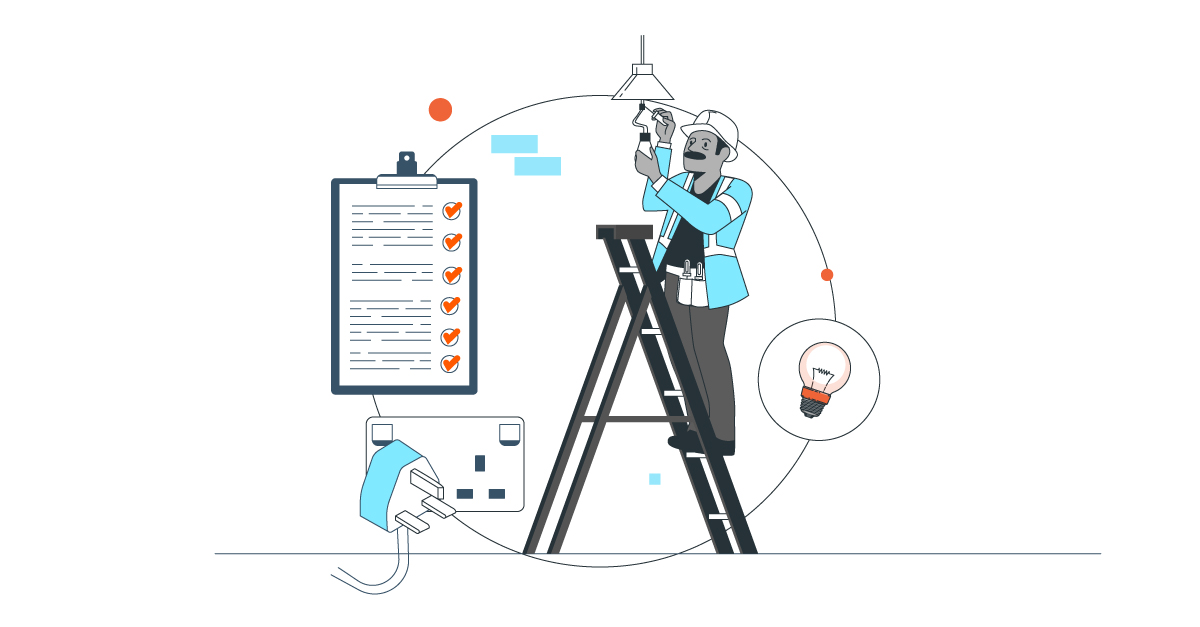
|
Highlights:
|
Electrical Installation Condition Report Guidance: What is an EICR?
Electrical installations are subject to wear and tear, and if they are not checked regularly, they can become dangerous. Wiring that is inadequately insulated or faulty can cause electrical fires.
An EICR report, also known as a periodic inspection report, is a thorough inspection of your property's electrical installation system to ensure electrical safety.
Why are EICRs important?
Electrical safety protects your residents’ lives and your property. Faulty or deteriorating installations cause more than 56% of home electrical fires.
Regular checks through an EICR help identify hidden risks before they become dangerous.
Any serious faults must be repaired immediately for the safety of existing tenants, or before the property is let out to new tenants.
But the importance of an EICR goes beyond safety.
It also helps:
-
Maintain property value: A property with up-to-date certification and no electrical issues is easier to sell, remortgage or re-let.
-
Protect insurance claims: Some insurers may reject claims for electrical fires if the landlord cannot show the property was properly inspected.
-
Provide peace of mind: Tenants are more confident knowing their home has passed formal safety checks, and landlords are likely to get fewer complaints and callouts.
EICR Rules Landlords Need to Know in 2025
New electrical safety regulations governing EICR inspections were enacted in 2020. These are the Private Rented Sector (England) Regulations 2020.
These are underpinned by the IET Wiring Regulations BS 7671.
They state that:
-
All private rented residential premises in England must have a valid EICR certificate.
-
Each property must be inspected every five years provided that a previous report has not identified an issue that needs attention sooner (more on this later).
-
A qualified electrician must issue the report and carry out any remedial work.
-
The report should include inspection results, the date the inspection was done, and the due date of the next inspection.
-
A copy of the report must be distributed to tenants within 28 days of inspection.
-
A copy of the report must be provided to the local housing authority within 7 days if requested.
-
A copy of the EICR report must be provided to the electrician who does the next one.
-
New tenants must be given a copy of the latest report before they move in.
It’s worth mentioning that EICR tests only cover fitted electrics. They do not cover appliances or electronics.
The Landlord and Tenant Act 1985 also mentions EICR tests, stating: “Electricity: landlords must provide and maintain safe electrical installations, including wiring, switches, circuit boards, light fittings and plug sockets, and have inspections carried out every five years.”
Landlords are also responsible for ensuring that residents understand the electrical safety requirements that must be adhered to during their tenancy.
The remedial work must be completed by a competent person with the appropriate qualifications.
⚠️ Failure to comply with these regulations can lead to serious penalties, including fines of up to £30,000.
You can view the legislation and penalties for non-compliance on the government’s website.
💡 Is PAT testing electrical appliances required?There is no legal requirement for landlords to carry out PAT tests in their properties. However, under the Landlord and Tenant Act 1985 (Section 11) and the Consumer Protection Act 1987 landlords are responsible for the safety of any appliances they provide. To ensure safety in your properties, you may wish to PAT test appliances you provide, like washing machines, fridges, and lamps. |
What Will the Electrician Do?
During an EICR inspection, the electrician checks and assesses electrics throughout the property, looking for deterioration and potential dangers that could cause shocks or electrical fires.
There are three main stages to an EICR inspection:
-
Visual assessment
-
Conducting an EICR test
-
Issuing the EICR report
-
Visual assessment
The electrician begins by conducting a visual assessment. The aim of the visual assessment is to identify anything that could present a danger to residents.
They will consider the home’s wiring, sockets, light fittings, and the fuse box (consumer unit), along with the overall condition of the system.
Here’s what they typically check:
-
Consumer unit (fuse box): Is it modern, safe, and fitted with protective devices like RCDs that prevent electric shock?
-
Wiring: Are cables in good condition, properly insulated, and free from signs of overheating or damage?
-
Sockets and switches: Are fittings secure, undamaged and correctly wired?
-
Light fittings: Are there any signs of deterioration, loose parts, or exposure to moisture?
-
Earthing and bonding: These systems are checked to ensure that if something goes wrong, the electricity has a safe path to ground.
-
Overloaded electrical circuits: The electrician will look for signs of circuits drawing too much current, which can pose a fire risk.
-
Non-compliant work: Any previous DIY jobs or outdated installations that don’t meet current electrical safety standards will be flagged.
-
Conducting an EICR test
The electrics are then disconnected from the power supply. The electrician tests the circuits to assess whether there are poorly connected wires.
The preliminary test is referred to as ‘dead testing’, and it is performed with the power switched off. This reduces the risk of sparks, explosions or electrical fires.
Live electrical testing will also be conducted. This helps identify defective wiring, as well as earth leakages, and instances of socket overloading.
-
Issuing the EICR report
When the electrician has completed the check, the EICR report is sent to the landlord.
The report includes whether the property is safe or unsafe. Remedial action will be listed and this must be carried out prior to tenants moving in.
What do the EICR codes mean?
Once the inspection is complete, the electrician will issue a report with a list of observations and a summary of the overall condition of the property’s electrics.
Each issue is assigned a classification code, which indicates its severity and the action needed.
Here’s what the codes mean:
-
C1 - Danger present: This means there’s an immediate risk of electric shock or fire. Action must be taken immediately to make it safe. Otherwise, the property will automatically be rated as “unsatisfactory.”
-
C2 - Potentially dangerous: This issue is not immediately hazardous but could become dangerous over time. It must be fixed urgently to ensure continued safety.
-
C3 - Improvement recommended: This doesn’t require urgent action, and won’t cause a “fail” on the report. But it highlights areas where upgrading or updating could improve safety.
-
FI - Further investigation required: Something appears to be wrong, but more detailed checks are needed to determine whether it poses a danger.
What happens after the report?
If the EICR includes any C1, C2, or FI codes, the landlord is legally required to act.
Here’s what must happen next:
-
Fix urgent issues quickly: Any C1 or C2 faults must be resolved within 28 days (or sooner, if the report specifies). The remedial work must be completed by a competent person with the appropriate qualifications.
-
Arrange further investigation if needed: If an FI (Further Investigation) code is recorded, this should be carried out as soon as possible to determine whether the issue is dangerous.
-
Provide written confirmation: Once the work is done, landlords must obtain written evidence that the problems have been fixed. This confirmation must be:
-
Given to the tenant within 28 days.
-
Shared with the local housing authority within 7 days if they request it.
How Long is an EICR Valid for?
As mentioned earlier, an Electrical Installation Condition Report is typically valid for five years from the date of the inspection. This is the legal minimum standard for privately rented homes in England under the 2020 regulations.
However, the report itself may recommend a shorter interval between electrical inspections, especially if the property is older or has electrical issues that need closer monitoring. Landlords should always check the “next inspection due” date listed in the report.
It’s also worth noting that:
-
A new EICR isn’t always needed between tenancies, unless the current certificate has expired or remedial work has been carried out since the last inspection.
-
Some HMO licences or insurance policies may require more frequent checks.
Keeping the inspection date in your records and setting a reminder well in advance helps ensure compliance and avoid last-minute scrambles.
How Much Will the EICR Cost?
The cost of conducting an EICR depends on the size of the property and the complexity of the electrics and the wiring. The rate may also depend on the experience and qualifications of the electrician, and each will have their own hourly rate.
The average cost is:
-
Electrician: £80 - £200 (per hour)
-
EICR: £150 - £225 (one bedroom)
-
EICR: £300+ (five bedrooms)
🛠️ The cost of the safety check does not include repairs done on the day; any remedial work will be quoted for and invoiced separately.
Stay EICR Compliant With EVO
For busy landlords, keeping up with electrical safety standards is one of many responsibilities.
With new certificates due every five years, inspections to book, and report copies to send out, it’s easy for essential tasks to slip between the cracks. Missing a deadline could result in a fine of up to £30,000.
EVO can help. Our digital platform provides an end-to-end solution for landlords to outsource all of their repairs, maintenance, safety checks and compliance.
This reduces your workload, ensures you never miss important dates and keeps you compliant.
EVO achieves this using a combination of modern technology and automation.
✔️ Residents are given an app to manage their own repairs and can choose a repair time that suits them.
✔️ All jobs are automatically sent to the next suitably qualified tradesperson, along with all the property information they need to understand the requirements and fix the root cause.
✔️ All work is signed off by our team and is given a 12-month warranty.
Our platform has helped one housing provider achieve a first-time fix rate of 96% and reduce their repair resolution rate from over 28 days to just 6.
To make things even easier, EVO offers an optional compliance add-on that includes electrical safety checks like EICRs. It also covers gas safety, fire safety, and smoke and carbon monoxide alarms, helping you stay compliant across your rental properties.
Keeping Your Rental Property Safe and Compliant
Staying compliant with electrical safety regulations isn’t just about ticking a box - it’s about protecting your tenants, your property, and your reputation as a responsible landlord.
Understanding what an EICR covers, how often it’s required, and what to do if issues arise is essential.
But you don’t have to do it all alone. With tools like EVO’s digital platform and compliance add-on, it’s easier than ever to stay compliant, avoid fines, and keep your properties safe.
📞 Contact us today to learn how EVO can help make property maintenance easier for you.
PHOTO BY EVO


